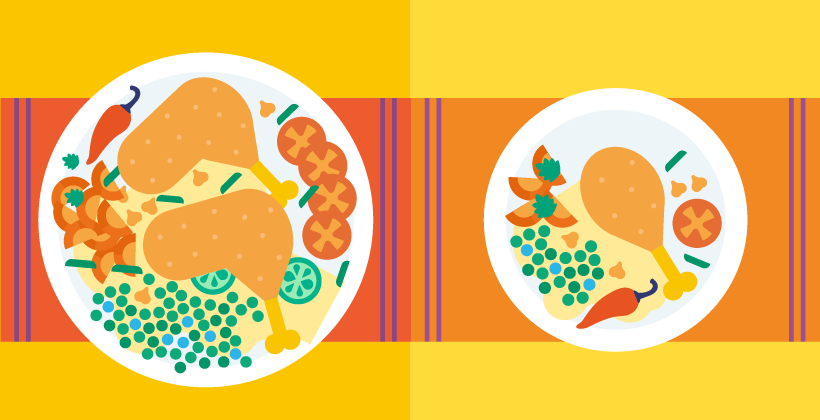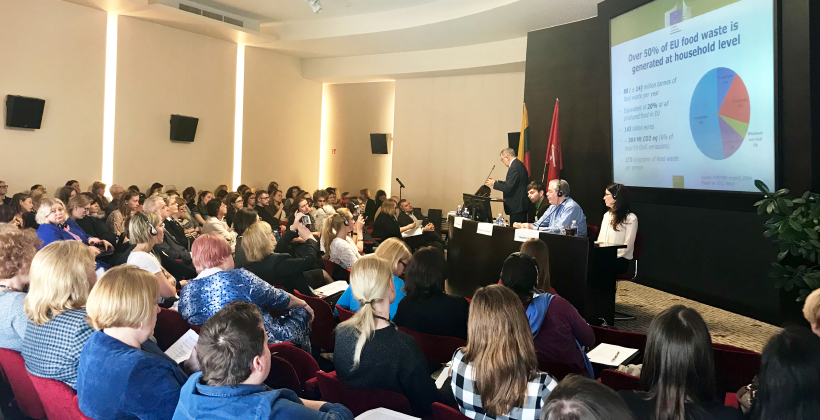What do you need to know about portion sizes - Q&A
Last Updated : 27 September 2018What is a portion size of food?
It is simple! A portion is how much food or drink we choose to eat at each occasion. It could be a lot or a little and depends on the choices we make. While the amount of food we eat is our decision, we can be influenced by the amount of food served in restaurants or provided in packs by food producers.1
Why should we pay attention to the size of a portion?
Understanding what a right portion is can help us eating more healthily and avoid under- and overeating.2 What drives our food choices is complex and many factors can play a role – from social to psychological.3 Sometimes, the amount of food or the feeling of fullness do not even seem to matter. This could be because:
- we eat in a hurry, or mindlessly,
- we often eat all the food that has been served on our plate,
- we simply do not know how much we should be eating,
- we select larger portions for better value for money.
On some food packaging the portion size is mentioned, on others it is not. Why?
In the EU, food producers may, but do not have to state a portion size on the packaging. The information that must be mentioned on the food packs, include:
- How much product the pack contains in total,
- Which nutrients and how much of them are present in 100g or 100ml of the given food product. 4,5
For more detail, check our simple visual on nutrition information on pack.
Who decides on the size of the portion stated on the food package, if it is mentioned?
Generally, portion sizes are not standardised in Europe, and can vary depending on the brand, product, or producer.7 However, several industry associations have developed standard portion sizes to provide consistent information, ensuring that certain foods or beverages are labelled with the same portion size, regardless of a brand.5,6,8 For example, soup producers discussed and recommended a portion of soup to be 250ml. The European soft drinks industry trade association also set the reference portion size at 250ml and the European breakfast cereals producers agreed on a range (30-45g) of portion sizes for different types of cereals. 9,10,15
Food manufactures, if they wish, can also specify ‘per serving’ information. The ‘per serving’ information offered by food producers is not the recommended quantity to consume. Rather, it is the quantity of food an average adult is expected to consume and how it contributes to the overall diet. For example, 100g butter of butter contains, on average, 80g of fat. In reality, we do not eat 100g of butter at once. Therefore, providing information per serving of butter – for example per 10g – will reflect better the contribution of this food to our diet.
Is serving size the same as a portion size?
This can be quite confusing! Sometimes a portion size and a serving size are the same, but they may differ. We now know that portion is the amount of food we choose to eat whereas the serving size is a specific, measured amount of food, like a spoon, a glass or a slice. Imagine a loaf of bread. The recommended serving size might be 1-2 slices, but the portion you choose to eat can vary. It can depend on how you want to eat the bread, what else you are eating with it and how much you need.
Unpacked food? No portion size recommended? How do we know how much to eat?
Dietary guidance provided by each country, often represented as a food pyramid or a plate, can be a good start. You can use them to know what foods to eat and in what proportions, to achieve a healthy and balanced diet. Does your country have its own food pyramid or an Eatwell plate that you can refer to? You can find it out at this page of the FAO website.
We should also always remember that some foods provide more energy than others, meaning they provide more calories per serving. This is called ‘energy density‘. For example, ice cream made of full fat cream and sugar can be classified as high energy density food. On the other hand, majority of fruit and vegetables have low energy density. Therefore, the portion size of fruit and veg would need to be bigger than that of ice cream to provide the same amount of calories. Low energy density foods are often rich in nutrients. While, high energy density foods should be enjoyed in moderation, keeping an eye on those portion sizes.
As a general guide, try to follow these tips:
- Eat at least five different portions of colourful fruit and vegetables every day
- Make potatoes, bread, rice, pasta or other starchy carbohydrates a base of a meal, choosing wholegrain where possible 14
- Aim to include dairy (or dairy alternatives) every day, choosing lower fat and lower sugar options
- Eat proteins like beans, pulses, fish, eggs and meat (including 2 portions of fish every week, one of which should be oily)
- Hydration: Drink 6-8 glasses of water (up to 1.5-2 litres) a day, or alternatively, have non-caloric/sugar-free teas and infusions. Plain coffee can also contribute to your water intake, however keep in mind that it’s not recommended to have more than 400 mg of caffeine a day. During warm weather or if you do physical activity you may need to drink more water!
Eating in a restaurant and overwhelmed by the portion of food in front of you?
In restaurants, if the meal you are served seems too much, ask your server to remove half of the amount immediately and pack it for you to take it home. This not only helps with managing how much you eat, but it also avoids food waste by providing another meal for the following day!
Can I easily estimate how much a portion should be?
We should watch our portion sizes and match them with advised serving sizes. For estimating the right amount or the right portion, we can use our hands, some visual comparisons or simple measuring tools that can be found in our kitchen.10,11
For example,12 one serving and therefore a portion of:
- fruit is one small apple or a handful of berries
- vegetables is one medium-sized carrot or two handfuls of sliced broccoli (which is approximately 80g)
- bread is one slice or half a bagel
- meat can fit on the palm of your hand
- cheese is a size of a small match box
- water should fill a glass
- butter can be measured with a teaspoon
What about children? Surely their portions are smaller!
That is right! How much food we need and therefore, the size of our portions varies depending on our weight, sex and gender, health, and how active we are. Do you remember a food pyramid? It can be used as a reference for children over 2 years old. Just remember, when adjusting a portion size for the little tummies, the overall balance of food groups should stay the same, it is the portion size that matters. We can still use hands as a guide to individual portions. For example, if a handful of berries is one portion, children will hold less and therefore consume less than the adults. What a useful measuring tool always in our pockets!
How can we control the portion sizes?
Understanding how much we need to eat takes practice, but there are some tricks to keep portion sizes under control:
- Use smaller plates
- Slow down and be more mindful while eating
- Skip seconds/do not go for second helping if you’re feeling full already
- Do not eat directly out of boxes
- Learn to read food labels
- Repackage supersize bags into individual portions
- Use measuring tools such as spoons, mugs and cups
- Use our infographic as a guide for choosing a correct portion size
- Eat regularly, consciously, and enjoy it with friends and family!12,13
References
- Benton D (2015). Portion Size: What We Know and What We Need to Know. Critical Reviews in Food Science and Nutrition 55(7):988-1004.
- Steenhuis I & Poelman M (2017). Portion Size: Latest Developments and Interventions. Current Obesity Reports 6(1):10-17.
- Hollands GJ, et al. (2015). Portion, package or tableware size for changing selection and consumption of food, alcohol and tobacco. Cochrane Database of Systematic Reviews 9: CD011045.
- Regulation (EU) No 1169/2011 of the European Parliament and of the Council of 25 October 2011 on the provision of food information to consumers.
- EUFIC (2012). The importance of portion information from a consumer and health perspective. EUFIC Review.
- Food Drink Europe Website. Portion Sizes For Purposes of Nutrition Labelling.
- Council conclusions on food product improvement (2016/C 269/04)
- EU Platform on Diet, Physical Activity and Health – Portion Sizes
- AAIIBP and FAIBP (2009). Portion Sizes for SOUPS in Europe, Draft 2 as of 17 July 2009.
- UNESDA website with reference portion size
- NHS Health Scotland (2008). Exploration of Adult Food Portion Size Tools. Edinburgh, Scotland: NHS
- Faulkner GP, et al. (2016). An evaluation of portion size estimation aids: precision, ease of use and likelihood of future use. Public health Nutrition 19(13): 2377-2387.
- EUFIC (2006). Adult nutrition.
- EUFIC (2014). Whole grain (Q&A).
- European Breakfast Cereal Association (2016). Portion sizes rationale


